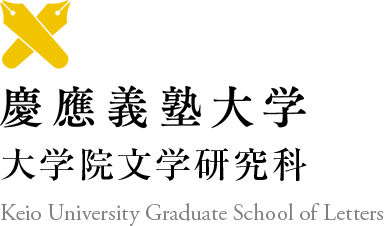Overview
Following the formation of Keio University’s Department of Japanese Language Education in 1958, a course for training Japanese language educators was established in 1972. In 2007, it was restructured to form the postgraduate Japanese Language Education Program within the Department of Japanese Literature. Our main objective is to qualify professionals in the fields of the Japanese language and Japanese language education and equip them with specialized expertise. Our curriculum and research rest on the two main pillars of acquiring solid theoretical base knowledge of phonetics, phonology, grammar, vocabulary, graphemics, and orthography and putting this theoretical knowledge into practice. Another axiom of this program is to enable non-native speakers of Japanese to make active use of their language skills in order to adapt to Japanese social customs and meaningfully participate in cultural exchange. Moreover, because our academic faculty largely belong to the Keio University Center for Japanese Studies, postgraduate students are regularly provided with opportunities to acquire practical teaching experience in the form of teaching assistantships and otherwise.
Faculty
Name/Position
Department/Specialty/Research Interest/Publication
-
 OHBA, MihokoProfessorm-ohba@keio.jp
OHBA, MihokoProfessorm-ohba@keio.jpJapanese Language Education
Japanese Linguistics, Japanese Language Education
Publication- 学位論文(博士):「日本語のアスペクトと関わる補助動詞についての研究」提出先:東京大学大学院人文社会系研究科基礎文化研究専攻(博士(文学)博人社第449号)
- 「日本語の助動詞「ようだ」と「らしい」の違いについて」『マテシス・ウニウェルサリス』3-2獨協大学外国語学部言語文化学科 pp.99-114
- 「実現可能文の用法について」『日本語と日本語教育』40 慶應義塾大学日本語・日本文化教育センター pp.1-17
- 「非情の受身の扱いに関する一考察」『日本語と日本語教育』45慶應義塾大学日本語・日本文化教育センター pp.1-18
- 「「わけだ」と「というわけだ」 -補文標識「という」の介在-」『日本語と日本語教育』52慶應義塾大学日本語・日本文化教育センター pp.1-18
-

Japanese Language Education
Japanese LanguageI mainly research the history of vocabulary, spelling, and how kango (漢語) is used in the modern Japanese language (from the late-Edo and Meiji eras through today). Analysis of dictionaries (Japanese, bilingual, and other specialty dictionaries) in each era is a big topic as well. At the same time, I also consider the history of discourse structure based on the colloquial data of each era.
Publication- 『図解日本語 第2版』(三省堂、2024)
- 『辞書の成り立ち』(2021、朝倉書店)
- 『わかりやすい日本語』(くろしお出版、2016)
- 『新選国語辞典 第10版』(小学館、2022)
-
 TANAKA, TaekoProfessortanaka3@ic.keio.ac.jp
TANAKA, TaekoProfessortanaka3@ic.keio.ac.jpJapanese Language Education
Publication- 「会話の応答におけるメタ言語表現の使用―言語形式への言及―」『日本語と日本語教育』51(2023)
- 「会話の応答に見られるメタ言語表現―シナリオを例として―」『日本語と日本語教育』46(2018)
- 「質問に対する回答回避発話―ドラマのシナリオを例に―」『日本語と日本語教育』44(2016)
- 「ドラマのシナリオに見られる『励まし発話』の諸相」『日本語と日本語教育』43(2015)
- 「ドラマのシナリオに見られる『慰め発話』の諸相」『日本語と日本語教育』40(2012)


